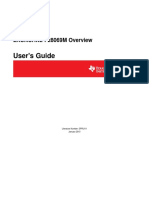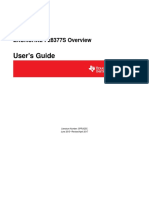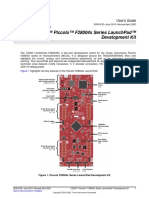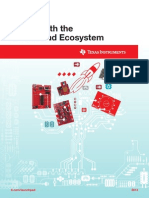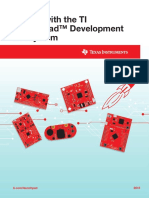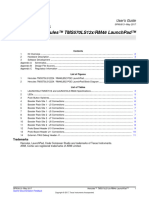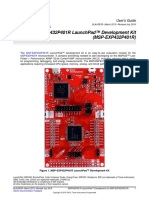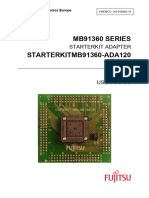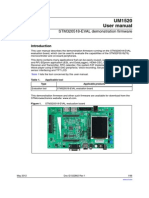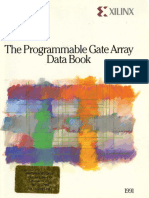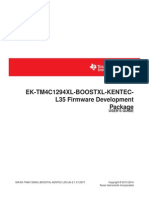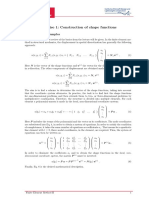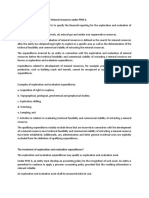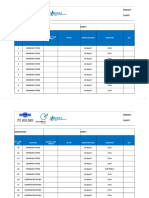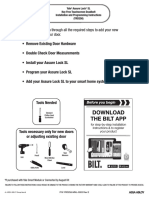LAUNCHXL-F28069M Overview: User's Guide
Uploaded by
zhifeng yanLAUNCHXL-F28069M Overview: User's Guide
Uploaded by
zhifeng yanUser's Guide
SPRUI11B – January 2015 – Revised March 2019
LAUNCHXL-F28069M Overview
Contents
1 Introduction ................................................................................................................... 2
2 Kit Contents................................................................................................................... 3
3 Installation .................................................................................................................... 3
4 Getting Started With the LAUNCHXL-F28069M ......................................................................... 4
5 Hardware Configuration ..................................................................................................... 5
6 LAUNCHXL-F28069M Hardware .......................................................................................... 9
7 Frequently Asked Questions (FAQ) ...................................................................................... 22
8 References .................................................................................................................. 23
List of Figures
1 LAUNCHXL-F28069M Board Overview .................................................................................. 3
2 USB Serial Port .............................................................................................................. 5
3 Boot Switch Orientation ..................................................................................................... 6
4 LAUNCHXL-F28069_B_1400922 Block Diagram Schematic ........................................................ 11
5 LAUNCHXL-F28069_B_1400922 USB to JTAG Schematic ......................................................... 12
6 LAUNCHXL-F28069_B_1400922 F28069_A Schematic ............................................................. 13
7 LAUNCHXL-F28069_B_1400922 F28069_B Schematic ............................................................. 14
8 LAUNCHXL-F28069_B_1400922 Connector Schematic ............................................................. 15
9 LAUNCHXL-F28069_B_1400922 Logic Choice Schematic .......................................................... 16
10 LAUNCHXL-F28069_B_1400922 Power Schematic .................................................................. 17
11 Top Silk ...................................................................................................................... 18
12 Top Copper ................................................................................................................. 18
13 Inner Copper 1.............................................................................................................. 18
14 Inner Copper 2.............................................................................................................. 18
15 Bottom Silk .................................................................................................................. 18
16 Bottom Copper.............................................................................................................. 18
List of Tables
1 Serial Connectivity ........................................................................................................... 6
2 ..................................................................................................... 7
S1 Boot Mode Settings
3 F28069M LaunchPad Pin Out and Pin Mux Options - J1, J3 .......................................................... 9
4 F28069M LaunchPad Pin Out and Pin Mux Options - J4, J2 .......................................................... 9
5 F28069M LaunchPad Pin Out and Pin Mux Options - J5, J7 ........................................................ 10
6 F28069M LaunchPad Pin Out and Pin Mux Options - J8, J6 ........................................................ 10
7 LAUNCHXL-F28069M Bill of Materials .................................................................................. 19
SPRUI11B – January 2015 – Revised March 2019 LAUNCHXL-F28069M Overview 1
Submit Documentation Feedback
Copyright © 2015–2019, Texas Instruments Incorporated
Introduction www.ti.com
Trademarks
C2000, Piccolo, LaunchPad, Code Composer Studio are trademarks of Texas Instruments.
Windows is a registered trademark of Microsoft Corporation in the United States and/or other countries.
All other trademarks are the property of their respective owners.
1 Introduction
The C2000™ Piccolo™ LaunchPad™, LAUNCHXL-F28069M, is a complete low-cost development board
for the Texas Instruments Piccolo F2806x devices and InstaSPIN technology. The LAUNCHXL-F28069M
kit features all the hardware and software necessary to develop applications based on the F2806x
microprocessor. The LaunchPad is based on the superset F28069M device, and easily allows users to
migrate to lower cost F2806x devices once the design needs are known. It offers an on-board JTAG
emulation tool allowing direct interface to a PC for easy programming, debugging, and evaluation. In
addition to JTAG emulation, the USB interface provides a universal asynchronous receiver/transmitter
(UART) serial connection from the F2806x device to the host PC.
Users can download an unrestricted version of Code Composer Studio™ IDE to write, download, and
debug applications on the LAUNCHXL-F28069M board. The debugger is unobtrusive, allowing the user to
run an application at full speed with hardware breakpoints and single stepping available while consuming
no extra hardware resources.
As shown in Figure 1, the LAUNCHXL-F28069M C2000 LaunchPad features include:
• USB debugging and programming interface via a high-speed galvanically isolated XDS100v2 debug
probe featuring a USB/UART connection
• Superset F28069M device that allows applications to easily migrate to lower cost devices
• Two user LEDs
• Device reset pushbutton
• Easily accessible device pins for debugging purposes or as sockets for adding customized extension
boards
• InstaSPIN library in ROM, allowing implementation of InstaSPIN-MOTION and InstaSPIN-FOC
solutions
• Dual 5 V quadrature encoder interfaces
• CAN Interface with integrated transceiver
• Boot selection switches
2 LAUNCHXL-F28069M Overview SPRUI11B – January 2015 – Revised March 2019
Submit Documentation Feedback
Copyright © 2015–2019, Texas Instruments Incorporated
www.ti.com Kit Contents
Figure 1. LAUNCHXL-F28069M Board Overview
2 Kit Contents
The LAUNCHXL-F28069M LaunchPad experimenter kit includes the following items:
• C2000 LaunchPad Board (LAUNCHXL-F28069M)
• Mini USB-B Cable, 0.5m
• Quick Start Guide
2.1 Revisions
The first and only production released of the LAUNCHXL-F28069M in 2014 was revision 1.2.
All Revisions:
• Resistor R7 in the oscillator circuit is incorrectly placed or should not be installed. This resistor may
impact startup time or robustness of the clocking circuit over the full operating range of the MCU or
different physical layouts of this circuit. The probability is low that this resistor will have any impact on
the functionality of this EVM as is not intended to be operated outside of Standard Temperature and
Pressure in a lab or prototype environment. Do not use this circuit as reference. For more information
on the Follow the requirements for the oscillator schematic, see the device-specific data sheet.
3 Installation
The F28069M LaunchPad is supported in both Code Composer Studio and Energia. Depending on your
tools preference you may wish to install one or the other or both.
3.1 Energia
Go to Energia.nu and and click on the Guide tab. Click on the link for your operating system and follow the
directions to install Energia.
SPRUI11B – January 2015 – Revised March 2019 LAUNCHXL-F28069M Overview 3
Submit Documentation Feedback
Copyright © 2015–2019, Texas Instruments Incorporated
Installation www.ti.com
3.2 Code Composer Studio
3.2.1 Download the Required Software
Code Composer Studio IDE (www.ti.com/ccs) is available for free without any restriction when used with
the XDS100v2 debug probe on the C2000 LaunchPad. Drivers, examples, and other support software
needed to get started are distributed through C2000Ware (www.ti.com/tool/c2000ware) and controlSUITE
(www.ti.com/tool/controlsuite). C2000Ware is the recommended download for new installations.
For InstaSPIN motor control projects, install and run the latest version of MotorWare.exe
(www.ti.com/motorware). In the window that opens, under Resources, follow the Kit Readme and GUI
Quick Start Guide for the LAUNCHXL-F28069M.
3.2.2 Install the Software
Once downloaded, install Code Composer Studio and C2000Ware or controlSUITE.
3.2.3 Install the Hardware
After Code Composer Studio is installed, plug the supplied USB cable into the C2000 LaunchPad board
and into an available USB port on your computer.
Windows® will automatically detect the hardware and ask you to install software drivers. Let Windows run
a search for the drivers and automatically install them. After Windows successfully installs the drivers for
the integrated XDS100v2 debug probe, your LaunchPad is now ready for use.
NOTE: If the USB Serial COM Port is not identified by the computer, reprogram the XDS100v2
EEPROM using these instructions.
4 Getting Started With the LAUNCHXL-F28069M
4.1 Getting Started
The first time the LAUNCHXL-F28069M is used, a demo application automatically starts when the board is
powered from a USB host. If your board does not start the demo application, try placing S1 in the following
positions and resetting the board: UP - UP - DOWN. To start the demo, connect the LAUNCHXL-
F28069M with the included mini-USB cable to a free USB port. The demo application starts with the LEDs
flashing to show the device is active.
4.2 Demo Application, Internal Temperature Measurement
The LAUNCHXL-F28069M includes a pre-programmed TMS320F28069M device. When the LaunchPad is
connected via USB, the demo starts with an LED flash sequence. After a few seconds the device switches
into a temperature measurement mode.
A reference temperature is taken at the beginning of this mode and the LEDs of the LaunchPad are used
to display any difference between the current temperature and the reference temperature. If the device
gets warmer than the reference temperature the red LED is lit with an intensity proportional to the
temperature difference. However, if the device cools down compared to the reference temperature, a blue
LED is lit in the same fashion.
In addition to the LED display, temperature information is also displayed on your PC through the
USB/UART connection. To view the UART information on your PC, first figure out the COM port
associated with the LaunchPad. To do this in Windows, right click on My Computer and click on
Properties. In the dialog box that appears, click on the Hardware tab and open Device Manager. Look for
an entry under Ports (COM & LPT) titled "XDS100 Class USB Serial Port (COMX)", where X is a number.
4 LAUNCHXL-F28069M Overview SPRUI11B – January 2015 – Revised March 2019
Submit Documentation Feedback
Copyright © 2015–2019, Texas Instruments Incorporated
www.ti.com Getting Started With the LAUNCHXL-F28069M
Figure 2. USB Serial Port
NOTE: If the USB Serial COM Port is not identified by the computer, reprogram the XDS100v2
EEPROM using these instructions.
Remember this number for when you open a serial terminal. The demo applications UART data was
written and debugged using PuTTY, and for the best user experience we recommend you use PuTTY to
view the UART data. PuTTY can be downloaded from the following URL:
http://www.chiark.greenend.org.uk/~sgtatham/putty/download.html
Open your serial terminal program and open the COM port you found previously in device manager with
the following settings: 115200 Baud, 8 data bits, no parity, 1 stop bit. After opening the serial port in your
serial terminal, reset the Launchpad with the reset push button and observe the serial terminal for a
surprise.
4.3 Program and Debug the Temperature Measurement Demo Application
The project and associated source code for the C2000 Piccolo LaunchPad demo is included in the
controlSUITE software package and should automatically be found by the TI Resource Explorer in Code
Composer Studio v6. In the resource explorer, open the controlSUITE folder and then the Development
Tools entry and look for the C2000 LaunchPad line item. Expand this item and LAUNCHXL-F28069M,
then select the LaunchPad Demo Application. Follow the steps in the main pane of the resource explorer
to import, build, debug, and run this application.
5 Hardware Configuration
The F28069M LaunchPad gives users several options as to how to configure the board.
5.1 Power Domain
The F28069M LaunchPad has several different power domains to enable JTAG isolation. Jumpers JP1,
JP2, JP3, JP4, and JP5 configure where power is passed.
Jumper Power Domain
JP1 Enable 3.3 V from USB (disables isolation)
JP2 Enable GND from USB (disables isolation)
JP3 Enable 5 V switcher (powered off 3.3 V supply of target device)
JP4 Connects target MCU 3.3 V to second set of BoosterPack
headers
JP5 Connects target MCU 5 V to second set of BoosterPack headers
SPRUI11B – January 2015 – Revised March 2019 LAUNCHXL-F28069M Overview 5
Submit Documentation Feedback
Copyright © 2015–2019, Texas Instruments Incorporated
Hardware Configuration www.ti.com
5.2 Serial Connectivity
The LAUNCHXL-F28069M has a USB to UART adapter built in. This makes it easy to print debug
information back to the host PC even in isolated environments. The F28069M device on this LaunchPad
contains two SCI (UART) peripherals, while the LaunchPad has three places these peripherals need to be
routed. Because of this, a serial connectivity mux has been added to the board to make configuration of
the SCI routing easy. Routing is configured via two jumpers (JP6 and JP7). Configure the jumpers as
shown in Table 1 for the serial connectivity you desire.
Table 1. Serial Connectivity
MUX_SEL CH_SEL(JP
(JP7) 6) Function
ON ON USB/UART Disabled; J1.3 and J1.4 – GPIO28 and GPIO29; J7.3 and J7.4 – GPIO15 and GPIO58
ON OFF USB/UART – GPIO28 and GPIO29, J1.3 and J1.4 – Hi-Z; J7.3 and J7.4 – GPIO15 and GPIO58
OFF ON USB/UART – GPIO15 and GPIO58; FAULT/OCTW – GPIO28 and GPIO29; J7.3 and J7.4 – Hi-Z
OFF OFF USB/UART – GPIO15 and GPIO58; FAULT/OCTW – GPIO28 and GPIO29; J7.3 and J7.4 – Hi-Z
NOTE: If the USB Serial COM Port is not identified by the computer, reprogram the XDS100v2
EEPROM using these instructions.
5.3 Boot Mode Selection
The LaunchPad's F28069M device includes a boot ROM that performs some basic start-up checks and
allows for the device to boot in many different ways. Most users will either want to perform an emulation
boot or a boot to flash (if they are running the application standalone). S1 has been provided to allow
users to easily configure the pins that the boot ROM checks to make this decision.
Figure 3. Boot Switch Orientation
6 LAUNCHXL-F28069M Overview SPRUI11B – January 2015 – Revised March 2019
Submit Documentation Feedback
Copyright © 2015–2019, Texas Instruments Incorporated
www.ti.com Hardware Configuration
The boot modes shown in Table 2 can be selected using S1:
Table 2. S1 Boot Mode Settings
S1-Switch 1 (GPIO34) S1-Switch 2 (GPIO37 / TDO) S1-Switch 3 (TRSTn)
Boot Mode H = Pulled to 1 H = Pulled to 1 H = XDS100v2 (1)
L = Pulled to 0 L = Pulled to 0 L = Tied to 0
Emulation Boot (2) L H H
Parallel IO L L L
SCI H L L
Wait L H L
GetMode H H L
(1) TRSTn is controlled by the XDS100v2 when Switch 3 is set to the H position. While connected to the device, TRSTn is driven to
1 by the XDS100v2. While disconnected from the device, TRSTn is pulled to 0.
(2) When the board is first powered on through the XDS100v2 USB port, the device will boot before the user can connect to the
device. Therefore, Switch 1 and Switch 2 should be configured to the Wait boot mode to hold the CPU in a safe state until the
user can connect to the device.
NOTE: The USB debugger cannot connect to the device when S1-Switch 3 is placed in the L
position because TSRTn is disconnected from the XDS100v2.
More information about boot mode selection can be found in the Boot ROM section of the TMS320x2806x
Piccolo technical reference guide.
5.4 Connecting a Crystal
Although the Piccolo device present on the LAUNCHXL-F28069M has an internal oscillator — and for
most applications this is sufficient — the LaunchPad offers a footprint for through-hole HC-49 crystals for
users who require a more precise clock. If you wish to use an external crystal, solder the crystal to the Q1
footprint and appropriate load capacitors to the C3 and C4 footprints. You also need to configure the
device to use the external oscillator in software.
5.5 Connecting a BoosterPack
The F28069M LaunchPad is the perfect experimenter board to start hardware development with the
F2806x devices. All of the connectors are aligned in a 0.1-in (2.54-mm) grid to allow easy and inexpensive
development of add on boards called BoosterPacks. These satellite boards can access all of the GPIO
and analog signals. The the pin out of the connectors can be found in Section 5.
SPRUI11B – January 2015 – Revised March 2019 LAUNCHXL-F28069M Overview 7
Submit Documentation Feedback
Copyright © 2015–2019, Texas Instruments Incorporated
Hardware Configuration www.ti.com
5.6 Device Migration Path
Applications developed on the LAUNCHXL-F28069M can easily be migrated to any of these lower cost
devices in the F2806x family:
Part Number Description
TMS320F28069 32-Bit Real Time Microcontroller, 90 MHz, 256KB Flash, 100KB RAM
TMS320F28069F 32-Bit Real Time Microcontroller, 90 MHz, 256KB Flash, 96KB RAM
TMS320F28069M 32-Bit Real Time Microcontroller, 90 MHz, 256KB Flash, 96KB RAM
TMS320F28068 32-Bit Real Time Microcontroller, 90 MHz, 256KB Flash, 100KB RAM
TMS320F28068F 32-Bit Real Time Microcontroller, 90 MHz, 256KB Flash, 96KB RAM
TMS320F28068M 32-Bit Real Time Microcontroller, 90 MHz, 256KB Flash, 96KB RAM
TMS320F28067 32-Bit Real Time Microcontroller, 90 MHz, 256KB Flash, 100KB RAM
TMS320F28066 32-Bit Real Time Microcontroller, 90 MHz, 256KB Flash, 68KB RAM
TMS320F28065 32-Bit Real Time Microcontroller, 90 MHz, 128KB Flash, 100KB RAM
TMS320F28064 32-Bit Real Time Microcontroller, 90 MHz, 128KB Flash, 100KB RAM
TMS320F28063 32-Bit Real Time Microcontroller, 90 MHz, 128KB Flash, 100KB RAM
TMS320F28062 32-Bit Real Time Microcontroller, 90 MHz, 128KB Flash, 52KB RAM
TMS320F28062F 32-Bit Real Time Microcontroller, 90 MHz, 128KB Flash, 52KB RAM
8 LAUNCHXL-F28069M Overview SPRUI11B – January 2015 – Revised March 2019
Submit Documentation Feedback
Copyright © 2015–2019, Texas Instruments Incorporated
www.ti.com LAUNCHXL-F28069M Hardware
6 LAUNCHXL-F28069M Hardware
6.1 Device Pin Out
The F28069M LaunchPad is not 100% compatible with the BoosterPack Standard pin out. to verify compatibility between a BoosterPack and this
LaunchPad, consult both the tables below as well as the pin out requirements of the BoosterPack. TI provides a tool that can help ease this
process. Use the Ti BoosterPack Checker tool. Some existing BoosterPacks can be used, or one can be created.
Table 3 through Table 6 lists the pin out and pin mux options for the C2000 LaunchPad.
The F28069M LaunchPad is not 100% compatible with the BoosterPack Standard pin out. to verify compatibility between a BoosterPack and this
LaunchPad, consult both the tables below as well as the pin out requirements of the BoosterPack. TI provides a tool that can help ease this
process. Use the TI BoosterPack Checker tool. Some existing BoosterPacks can be used, or one can be created.
Table 3. F28069M LaunchPad Pin Out and Pin Mux Options - J1, J3
Mux Value Mux Value
3 2 1 0 J1 Pin J3 Pin 0 1 2 3
+3.3V 1 21 +5V
ADCINA6 2 22 GND
J1.3 3 23 ADCINA7
J1.4 4 24 ADCINB1
SPISIMOB SCITXDA TZ1 GPIO12 5 25 ADCINA2
ADCINB6 6 26 ADCINB2
XCLKOUT SCITXDB SPICLKA GPIO18 7 27 ADCINA0
SCITXDB MCLKXA EQEP1S GPIO22 8 28 ADCINB0
ADCSOCBO EPWMSYNCO SCLA GPIO33 9 29 ADCINA1
ADCSOCAO EWPMSYNCI SDAA GPIO32 10 30 NC
Table 4. F28069M LaunchPad Pin Out and Pin Mux Options - J4, J2
Mux Value Mux Value
3 2 1 0 J4 Pin J2 Pin 0 1 2 3
Rsvd Rsvd EPWM1A GPIO0 40 20 GND
COMP1OUT Rsvd EPWM1B GPIO1 39 19 GPIO19 SPISTEA SCIRXDB ECAP1
Rsvd Rsvd EPWM2A GPIO2 38 18 GPIO44 MFSRA SCIRXDB EPWM7B
COMP2OUT SPISOMIA EPWM2B GPIO3 37 17 NC
Rsvd Rsvd EPWM3A GPIO4 36 16 RESET#
ECAP1 SPISIMOA EPWM3B GPIO5 35 15 GPIO16 SPISIMOA Rsvd TZ2
SPISOMIB Rsvd TZ2 GPIO13 34 14 GPIO17 SPISOMIA Rsvd TZ3
SPRUI11B – January 2015 – Revised March 2019 LAUNCHXL-F28069M Overview 9
Submit Documentation Feedback
Copyright © 2015–2019, Texas Instruments Incorporated
LAUNCHXL-F28069M Hardware www.ti.com
Table 4. F28069M LaunchPad Pin Out and Pin Mux Options - J4, J2 (continued)
Mux Value Mux Value
3 2 1 0 J4 Pin J2 Pin 0 1 2 3
NC 33 13 GPIO50 EQEP1A MDXA TZ1
DAC1 32 12 GPIO51 EQEP1B MDRA TZ2
DAC2 31 11 GPIO55 SPISOMIA EQEP2B HRCAP2
Table 5. F28069M LaunchPad Pin Out and Pin Mux Options - J5, J7
Mux Value Mux Value
3 2 1 0 J5 Pin J7 Pin 0 1 2 3
+3.3 V 41 61 +5 V
NC 42 62 GND
J7.3 43 63 ADCINB7
J7.4 44 64 ADCINB4
COMP1OUT MDXA EQEP1A GPIO20 45 65 ADCINA5
NC 46 66 ADCINB5
SPICLKB SCITXDB TZ3 GPIO14 47 67 ADCINA3
COMP2OUT MDRA EQEP1B GPIO21 48 68 ADCINB3
SCIRXDB MFSXA EQEP1I GPIO23 49 69 ADCINA4
HRCAP1 EQEP2A SPISIMOA GPIO54 50 70 NC
Table 6. F28069M LaunchPad Pin Out and Pin Mux Options - J8, J6
Mux Value Mux Value
3 2 1 0 J8 Pin J6 Pin 0 1 2 3
EPWMSYNCO EPWMSYNCI EPWM4A GPIO6 80 60 GND
ECAP2 SCIRXDA EPWM4B GPIO7 79 59 GPIO27 HRCAP2 EQEP2S SPISTEB
ADCSOCAO Rsvd EPWM5A GPIO8 78 58 GPIO26 ECAP3 EQEP2I SPICLKB
ECAP3 SCITXDB EPWM5B GPIO9 77 57 NC
ADCSOCBO Rsvd EPWM6A GPIO10 76 56 RESET#
ECAP1 SCIRXDB EPWM6B GPIO11 75 55 GPIO24 ECAP1 EQEP2A SPISIMOB
NC 74 54 GPIO25 ECAP2 EQEP2B SPISOMIB
NC 73 53 GPIO52 EQEP1S MCLKXA TZ3
DAC3 72 52 GPIO53 EQEP1I MFSXA Rsvd
DAC4 71 51 GPIO56 SPICLKA EQEP2I HRCAP3
10 LAUNCHXL-F28069M Overview SPRUI11B – January 2015 – Revised March 2019
Submit Documentation Feedback
Copyright © 2015–2019, Texas Instruments Incorporated
6.2
1 2 3 4 5 6
www.ti.com
A A
Schematics
LEDS CAN
Sheet 4 Sheet 5
Submit Documentation Feedback
QEP Connector
Power management Sheet 5
B B
SPRUI11B – January 2015 – Revised March 2019
BoosterPack 1 Connector
Sheet 2 TMS320F28069 Sheet 5
BoosterPack 2 Connector
Sheet 5
Sheet 3&4
C C
Figure 4 shows the F28069M LaunchPad schematic.
Micro USB type B
FT2232H SERIAL 1&2
Sheet 2
Sheet 2
Copyright © 2015–2019, Texas Instruments Incorporated
D D
Note: DNP = Do Not Populate
REV DATA NOTE
Figure 4. LAUNCHXL-F28069_B_1400922 Block Diagram Schematic
REV1.0 20140806 ORIGINAL RELEASED Roy Yaung
E E
REV1.1 20140922 Add pullup resistances and filter capacitors for QEP net on sheet 5.
BLOCK DIAGRAM 1.1
LAUNCHXL-F28069M Overview
LAUNCHXL-F28069M Hardware
11
12
1 2 3 4 5 6
U17 Vout = 3.3V +5V
TPS62162DSGR Iout = 1A TP30 JP3
L7
CDRH2D18/HPNP-2R2NC
FTDI_3V3 FTDI_3V3
P$2 P$7
1
2
USBVCC VIN SW TP10
VOS P$6 2.2uH
P$3 LP_5V
EN
A FB P$5 R16 A
AGND
10uF
C43
820
R46
P$4 GND
0
C44 P$1 P$8 100K22uF R18
PGND PG 0.1u
R47 C45 0
P$9 EX_PAD
L2
L1
R19
D4
0
AGND
LAUNCHXL-F28069M Hardware
AGND AGND R20
BLM15AG601SN1D
BLM15AG601SN1D
AGND AGND
0
C11
4.7u
LAUNCHXL-F28069M Overview
JP1
AGND
1
2
AGND
F1
C10
+3V3
4.7u
Mini USB USBVCC TP12
500mA FTDI_1V8 FTDI_3V3 R21
B FTDI_3V3 B
P$9
P$4
P$12
P$37
P$64
P$20
P$31
P$42
P$56
1 R15 0R 0
2 D- U5
R33 0R D+ P$16 1 16
3 ADBUS0 VCC1 VCC2
4 ADBUS1 P$17 2 GND1 GND2 15
VPLL
P$18 3 14
VPHY
5 ADBUS2 INA OUTA TCK
VCCIO1
P$19
VCCIO2
VCCIO3
VCCIO4
FTDI_3V3 P$50 4 13 TDI
VCORE1
VCORE2
VCORE3
VREGIN ADBUS3 INB OUTB
P$49 VREGOUT ADBUS4 P$21 5 INC OUTC 12 TMS
ADBUS5 P$22 6 IND OUTD 11 SCI_RX
C12 C13 C14 C15 D- P$7 USBDM ADBUS6 P$23 7 NC EN 10
ADBUS7 P$24 8 GND1 GND2 9
0.1u 0.1u 0.1u 3.3u D+ P$8
AGND USBDP
ACBUS0 P$26
P$6 P$27 AGND ISO7240 GND
R22 REF ACBUS1
P$14 RESET# ACBUS2 P$28 FTDI_3V3 +3V3
P$29 U7 TP13
AGND AGNDAGNDAGND 1K ACBUS3
ACBUS4 P$30 16 VCC2 VCC1 1
C ACBUS5 P$32 R23 15 GND2 GND1 2 C
ACBUS6 P$33 1K 14 OUTA INA 3 TDO
ACBUS7 P$34 13 OUTB INB 4 SCI_TX
R24
12k
TP11 12 5 JTAG_TRST
AGND INC OUTC
FTDI_3V3 U6 BDBUS0 P$38 11 NC2 NC1 6
BDBUS1 P$39 10 EN2 EN1 7
BDBUS2 P$40 9 GND2 GND1 8
AGND FT2232H P$41
U8 BDBUS3
6
BDBUS4 P$43 ISO7231
FTDI_CLK 4 VCC FTDI_CS P$63 P$44
10K
R12
CLK EECS BDBUS5
P$62 P$45
1 JP2
2
FTDI_CLK EECLK BDBUS6 FTDI_3V3
FTDI_CS 5 CS FTDI_DATA P$61 EEDATA BDBUS7 P$46
C16
R31 P$48 R25
DO 1 FTDI_DATA BCBUS0 D7
EEPROM
Array
0.1u FTDI_DATA 3
DI 2.2k BCBUS1 P$52 0
GND P$2 P$53
Copyright © 2015–2019, Texas Instruments Incorporated
OSCI BCBUS2
R26
330
2
BCBUS3 P$54 GND
D P$3 P$55 R27 AGND R28 D
93LC56BT-I/OT OSCO BCBUS4
BCBUS5 P$57 330 0
P$58 D8
BCBUS6 R30
BCBUS7 P$59
12M 0
Q3 P$13 P$60 PWREN#
AGND TEST PWREN# R32
SUSPEND# P$36 SUSPEND#
C17 C18 0
TH
AGND
GND1
GND2
GND3
GND4
GND5
GND6
GND7
GND8
36p 36p
Figure 5. LAUNCHXL-F28069_B_1400922 USB to JTAG Schematic
TH
P$1
P$5
P$11
P$10
P$15
P$25
P$35
P$47
P$51
TP14TP15TP16TP17
Roy Yaung
E E
AGND USB TO JTAG 1.1
SPRUI11B – January 2015 – Revised March 2019
www.ti.com
Submit Documentation Feedback
1 2 3 4 5 6
www.ti.com
TP20TP21TP22TP23TP24
A +3V3 A
U1G$1
+3V3 TMS320F28069MPZT
GND
46 VDD_FL
Submit Documentation Feedback
C40 24
L4
VREFHI
L3
U1G$3
TMS320F28069MPZT 0.1u 90 27
TP19 VREGENZ VREFLO
BLM15PD600SN1D
25 GND 45 GND
BKP1005HS221-T
VDDA TEST2
ADC_INA7 16 ADCINA7
2.2u
C1 3 RESET# 11 17 ADCINA6
C2 2.2u 14 VDD1 XRS ADC_INA6/COMP3A/AIO6
VDD2 ADC_INA5 18 ADCINA5
C22 2.2u 37 VDD3 ADC_INA4/COMP2A/AIO4 19 ADCINA4
C23 2.2u 63 VDD4 VSSA 26 TRST 12 TRST ADC_INA3 20 ADCINA3
ADC
C5 2.2u 81 TCK 67 21 ADCINA2
SPRUI11B – January 2015 – Revised March 2019
B C6 2.2u 91 VDD5
4 72
TCK/GPIO38 ADC_INA2/COMP1A/AIO2
22
B
VDD6 VSS1 TMS TMS/GPIO36 ADC_INA1 ADCINA1
JTAG
VSS2 15 TDI 71 TDI/GPIO35 ADC_INA0 23 ADCINA0
GND 5 VDDIO1 VSS3 36 TDO 70 TDO/GPIO37
13 VDDIO2 VSS4 47 PWM
38 VDDIO3 VSS5 62 ADC_INB7 35 ADCINB7
61 VDDIO4 VSS6 80 GPIO18 51 XCLK_O/GPIO18 ADC_INB6/COMP3B/AIO14 34 ADCINB6
79 VDDIO5 VSS7 92 ADC_INB5 33 ADCINB5
93 VDDIO6 GPIO19 64 XCLK_I/GPIO19 ADC_INB4/COMP2B/AIO12 32 ADCINB4
ADC_INB3 31 ADCINB3
DNP ADC_INB2/COMP1B/AIO10 30 ADCINB2
36p
C3
C21 C19 C20C26C27C28C29C30 60 X1
CLOCK
ADC_INB1 29 ADCINB1
ADC_INB0 28 ADCINB0
2.2u 2.2u 2.2u2.2u2.2u2.2u2.2u2.2u
Q1
GND 59 X2
R7 1M
36p
C4
C GND C
GND
+3V3 +3V3
BOOT +3V3
+3V3
RESET
820
R5
820
R4
S1 S2
6 1 GPIO34
R6
2.2k
ON
5 2 TP18
2 1
TDO
3
3
JTAG_TRST 4 TRST RESET#
R1
820
Copyright © 2015–2019, Texas Instruments Incorporated
D 204-3ST TP-1138K9-BE1125C39
D
2.2k
R10
2.2k
R9
2.2k
R8
D1
0.1u
GND GND GND GND GND
GND
TRST TDO GPIO34
Figure 6. LAUNCHXL-F28069_B_1400922 F28069_A Schematic
1 x x Emulation Boot
0 0 0 Parallel I/O
0 0 1 SCI Roy Yaung
0 1 0 Wait
E 0 1 1 GetMode E
F28069_A 1.0
LAUNCHXL-F28069M Overview
LAUNCHXL-F28069M Hardware
13
14
1 2 3 4 5 6
U1G$2 TMS320F28069MPZT
A A
GPIO0 87 GPIO0/EPWM1A GPIO25/ECAP2/EQEP2B/SPISOMIB 39 GPIO25
GPIO1 86 GPIO1/EPWM1B/COMP1OUT GPIO26/ECAP3/EQEP2I/SPICLKB/USB0DP78 GPIO26
GPIO2 84 GPIO2/EPWM2A GPIO27/HRCAP2/EQEP2S/SPISTEB/USB0DM77 GPIO27
GPIO3 83 GPIO3/EPWM2B/SPISOMIA/COMP2OUT
GPIO4 9 GPIO4/EPWM3A GPIO28/SCI_RXDA/SDAA/TZ2 50 GPIO28
GPIO5 10 GPIO5/EPWM3B/SPISIMOA/ECAP1 GPIO29/SCI_TXDA/SCLA/TZ3 43 GPIO29
GPIO6 58 GPIO6/EPWM4A/EPWMSYNCI/EPWMSYNCOGPIO15/ECAP2/SCI_RXDB/SPISTEB 88 GPIO15 UART
PWM GPIO7 57 GPIO58
LAUNCHXL-F28069M Hardware
GPIO7/EPWM4B/SCIRXDA/ECAP2 GPIO58/MCLKRA/SCI_TXDB/EPWM7A94
GPIO8 54 GPIO8/EPWM5A/ADCSOCAO
GPIO9 49 GPIO9/EPWM5B/SCI_TXDB/ECAP GPIO30/CAN_RXA/EQEP2I/EPWM7A 41 GPIO30
74
LAUNCHXL-F28069M Overview
GPIO10 GPIO10/EPWM6A/ADCSOCBO GPIO31/CAN_TXA/EQEP2S/EPWM8A 40 GPIO31
GPIO11 73 GPIO11/EPWM6B/SCI_RXDB/ECAP1
GPIO40 82 GPIO40/EPWM7A/SCI_TXDB GPIO32/SDA_A/EPWMSYNCI/ADCSOCAO99 GPIO32
GPIO41 76 GPIO41/EPWM7B/SCI_RXDB GPIO33/SCL_A/EPWMSYNCO/ADCSOCBO100 GPIO33
GPIO42 1 GPIO42/EPWM8A/TZ1/COMP1OUT
GPIO43 8 GPIO43/EPWM8B/TZ2/COMP2OUT
B GPIO34/COMP2OUT/COMP3OUT 68 GPIO34 B
GPIO12 44 GPIO12/TZ1/SCITXDA/SPISIMOB
GPIO13 95 GPIO13/TZ2/SPISOMIB GPIO39 66 GPIO39
GPIO14 96 GPIO14/TZ3/SCITXDB/SPICLKB
GPIO44/MFSRA/SCIRXDB/EPWM7B 56 GPIO44
GPIO50/EQEP1A/MDXA/TZ1 42 GPIO50
GPIO20 6 GPIO20/EQEP1A/MDXA/COMP1OUT GPIO51/EQEP1B/MDRA/TZ2 48 GPIO51
GPIO21 7 GPIO21/EQEP1B/MDRA/COMP2OUT GPIO52/EQEP1S/MCLKXA/TZ3 53 GPIO52
GPIO23 2 GPIO23/EQEP1I/MFSXA/SCIRXDB GPIO53/EQEP1I/MFSXA 65 GPIO53
GPIO22 98 GPIO22/EQEP1S/MCLKXA/SCITXDB GPIO24/ECAP1/EQEP2A/SPISIMOB 97 GPIO24
GPIO57 89 GPIO57/SPISTEA/EQEP2S/HRCAP4
GPIO54 69 GPIO54/SPISIMOA/EQEP2A/HRCAP1 GPIO16/SPI_SIMO_A/TZ2 55 GPIO16
GPIO55 75 GPIO55/SPISOMIA/EQEP2B/HRCAP2 GPIO17/SPI_SOMI_A/TZ3 52 GPIO17
GPIO56 85 GPIO56/SPICLKA/EQEP2I/HRCAP3
C C
+3V3 +3V3 +3V3
C24
5
R38
330
R39
330
0.1u U9
PWM_DAC GND
VCC
TP8
D9
D10
GPIO34 1 1A 1Y 6
R36 1K
Copyright © 2015–2019, Texas Instruments Incorporated
D DAC1 TP7 GPIO40 D
R37 1K 3 4
DAC2 TP6 GPIO41 GPIO39 2A 2Y
R40 1K
GND
DAC3 TP5 GPIO42
R41 1K
DAC4 GPIO43 SN74LVC2G07
2
C35 C34 C33 C36
GND
0.1u 0.1u 0.1u 0.1u
Figure 7. LAUNCHXL-F28069_B_1400922 F28069_B Schematic
GND GND GND GND Roy Yaung
E E
F28069_B 1.1
SPRUI11B – January 2015 – Revised March 2019
www.ti.com
Submit Documentation Feedback
1 2 3 4 5 6
www.ti.com
JP4 JP5 +5V
1
2
1
2
+3V3
+3V3
PWR 41 PWR 61
A ANA 42 GND 62 A
FAULTn 43 J7.3 Vdc 63 ADCINB7
OCTWn 44 J7.4 V_A2 64 ADCINB4 1
45 GPIO20 V_B2 65 ADCINA5 2
ANA 46 V_C2 66 ADCINB5 3
2SPI_CLK 47 GPIO14 I_A2 67 ADCINA3
48 GPIO21 I_B2 68 ADCINB3 J9
Submit Documentation Feedback
SCL 49 GPIO23 I_C2 69 ADCINA4 GND
SDA 50 GPIO54 70
J5 J7 GND
2PWM_AH 80 GPIO6 GND 60
2PWM_AL 79 GPIO7 2SPI_CS 59 GPIO27
2PWM_BH 78 GPIO8 GPIO 58 GPIO26
2PWM_BL 77 GPIO9 57 +3V3
SPRUI11B – January 2015 – Revised March 2019
B 2PWM_CH 76 GPIO10 RESET 56 RESET# CAN C37
B
0.1u
2PWM_CL 75 GPIO11 2SPI_SI 55 GPIO24
74 2SPI_SO 54 GPIO25 U3
73 2EN_GATE 53 GPIO52 P$3
PWM_DAC 72 DAC3 2DC_CAL 52 GPIO53 SN65HVD234D
GND
R35
10K
PWM_DAC 71 DAC4 51 GPIO56 P$8 CANH
RS
VCC
J8 J6 P$5 P$7 1
EN CANH
2
GND 3
R34
120
GPIO31 R43 0R P$1 P$6
D CANL
J12
0R P$4
GND
+3V3 +5V GPIO30 R44 R CANL
PWR 1 PWR 21 PGND
10K
R42
P$2
ANA 2 ADCINA6 GND 22
C FAULTn 3 J1.3 Vdc 23 ADCINA7 C
OCTWn 4 J1.4 V_A1 24 ADCINB1
GPIO 5 GPIO12 V_B1 25 ADCINA2 GND GND
ANA 6 ADCINB6 V_C1 26 ADCINB2
1SPI_CLK 7 GPIO18 I_A1 27 ADCINA0
GPIO 8 GPIO22 I_B1 28 ADCINB0
9 GPIO33 I_C1 29 ADCINA1
10 GPIO32 30
J1 J3
GND
LEVEL SHIFT U2
1PWM_AH 40 GPIO0 GND 20 +5V +3V3
1PWM_AL 39 GPIO1 1SPI_CS 19 GPIO19 TXB0106PWR
C31
0.1u
1PWM_BH 38 GPIO2 GPIO 18 GPIO44 P$15 VCCB VCCA P$2
1PWM_BL 37 GPIO3 17
P$9 P$8 R2 2.2k
C32
1PWM_CH 36 GPIO4 RESET 16 RESET#
0.1u
GND OE
GND
Copyright © 2015–2019, Texas Instruments Incorporated
D 1PWM_CL 35 GPIO5 1SPI_SI 15 GPIO16 GND GND D
GPIO 34 GPIO13 1SPI_SO 14 GPIO17 EQEP1A P$16 B1 A1 P$1 GPIO20
33 1EN_GATE 13 GPIO50 EQEP1B P$14 B2 A2 P$3 GPIO21
PWM_DAC 32 DAC1 1DC_CAL 12 GPIO51 EQEP1I P$13 B3 A3 P$4 GPIO23
PWM_DAC 31 DAC2 11 GPIO55 EQEP2A P$12 B4 A4 P$5 GPIO54
EQEP2B P$11 B5 A5 P$6 GPIO55
J4 J2 EQEP2I P$10 B6 A6 P$7 GPIO56
GND
+5V +5V
Figure 8. LAUNCHXL-F28069_B_1400922 Connector Schematic
R13 1K
R29 1K
R48 1K
R49 1K
R50 1K
R51 1K
A 1 EQEP1A 1 EQEP2A
B 2 EQEP1B 2 EQEP2B
Roy Yaung
E I 3 EQEP1I 3 EQEP2I E
PWR 4 4
GND 5 5
0.001u
0.001u
0.001u
0.001u
0.001u
0.001u
QEP_A QEP_B
C50
C51
C52
C53
C54
C55
CONNECTOR 1.1
GND GND
LAUNCHXL-F28069M Overview
LAUNCHXL-F28069M Hardware
15
16
1 2 3 4 5 6
+3V3
MUX1 +3V3 U11
0.1u
C46
TS5A3153DCUR U13
5
SN74AHC1G32
0.1u
C48
P$8 V+
A P$6
A
GND
NO FAULT_O GND
+3V3 1 J1.3
TP9 A
GPIO28 P$1 COM NC P$7 J1.3 FAULT_O TP3 4 Y
B 2 J7.3
GND VCC
P$3 GND1 IN P$5 MUX_SEL
R3
P$4 P$2
R11
10K
10K
3
GND2 EN
LAUNCHXL-F28069M Hardware
GND CH_SEL
U15 GND
+3V3 TS5A3153DCUR MUX_SEL
LAUNCHXL-F28069M Overview
+3V3
0.1u
C49
P$8 V+ 2 2
P$6 OCTW_O 1 1
0.1u
C47
GND
JP6
JP7
NO 5
U14
GPIO29 TP27 P$1 P$7 J1.4 SN74AHC1G32
COM NC
B GND B
GND GND 1 J1.4
P$3 P$5 A
GND1 IN OCTW_O TP4 4
P$4 P$2 EN Y
GND2 EN 2 J7.4
B
GND VCC
GND
3
MUX2 GND
+3V3
+3V3
5
0.1u
C42
VCC
U16
TS5A23159DGSR C9
GND
U18P
P$8
C +3V3 C
P$1 P$2 0.1u
3
IN1 NO1
GND
0.1u
C7
TP28
V+
GPIO15 P$10 COM1 NC1 P$9 J7.3 U4
5
P$5 P$4 SN74AHC1G02DBVR GND
TP29 IN2 NO2
GPIO58 P$6 COM2 NC2 P$7 J7.4 GND
A 1 MUX_SEL
EN TP1 4 Y
P$3 V-
B 2 4 2 CH_SEL
GND VCC
GND U18A
3
SN74LVC1G04DCKR
GND
MUX_SEL
+3V3
Copyright © 2015–2019, Texas Instruments Incorporated
D ORG D
MUX_SELCH_SEL Channel Description
0 0 UART Disable ; GPIO28&29 — J1.3 & J1.4 ; GPIO15&58 — J7.3 & J7.4 .
GND
MUX_SEL
P$16
C38
0.1u
0 1 U11 & U15 Disable ; GPIO15&58 — J7.3 & J7.4 ; GPIO28&29 — UART .
P$6 INH S0 P$10 CH_SEL
P$9 1 0 U16 Disable ; GPIO28&29 — Fault & Octw ; GPIO15&58 — UART.
S1
VCC
P$12 1Y0
GPIO28 P$14 1 1 U16 Disable ; GPIO28&29 — Fault & Octw ; GPIO15&58 — UART.
1Y1
P$15 1Y2
GPIO15 P$11 P$13 TP25 SCI_RX
1Y3 1COM
Figure 9. LAUNCHXL-F28069_B_1400922 Logic Choice Schematic
P$1 P$3 TP26 SCI_TX
2Y0 2COM
GPIO29 P$5 2Y1
P$2 Roy Yaung
2Y2
P$4
GND1
GND2
E GPIO58 2Y3 E
U10
SN74LV4052APW
P$8
P$7
Logic Choice 1.1
GND
SPRUI11B – January 2015 – Revised March 2019
www.ti.com
Submit Documentation Feedback
www.ti.com LAUNCHXL-F28069M Hardware
D
A
1.1
6
Roy Yaung
Power
5
Iout = 0.5A
Vout = 5V
TP2
GND
10uF
C41
4
LP_5V
820p
C25
R17 R45
30.1K 10K
1N5819HW-7-F
D3
3
LMR62421XMFE/NOPB
1
3
SWITCH
CDRH3D16/HPNP-3R3NC
FB
GND
3.3uH
2
U12
L6
VIN
SD
5
R14
2
10K
4.7u
C8
+3V3
GND
1
D
A
Figure 10. LAUNCHXL-F28069_B_1400922 Power Schematic
SPRUI11B – January 2015 – Revised March 2019 LAUNCHXL-F28069M Overview 17
Submit Documentation Feedback
Copyright © 2015–2019, Texas Instruments Incorporated
LAUNCHXL-F28069M Hardware www.ti.com
6.3 PCB Layout
Figure 11 through Figure 16 shows the LAUNCHXL-F28069M PCB layout.
Figure 11. Top Silk Figure 12. Top Copper
Figure 13. Inner Copper 1 Figure 14. Inner Copper 2
Figure 15. Bottom Silk Figure 16. Bottom Copper
18 LAUNCHXL-F28069M Overview SPRUI11B – January 2015 – Revised March 2019
Submit Documentation Feedback
Copyright © 2015–2019, Texas Instruments Incorporated
www.ti.com LAUNCHXL-F28069M Hardware
6.4 Bill of Materials (BOM)
Table 7 lists the LAUNCHXL-F28069M bill of materials.
Table 7. LAUNCHXL-F28069M Bill of Materials
Working
S No Category MPN Per Mfg. Description Package Value Voltage Reference
1 PCB LAUNCHXL-F28069M PCB 1 4 layers PCB,Red Soldermask, white Silkscreen,
Immersion gold, 51 mm*130.5 mm,
LAUNCHXL-F28069M PCB
2 MCU TMS320F28069MPZT 1 TI MCU 32-bit C2000 C28x RISC 128KB Flash 3.3 V LQFP-100 1.71~1.995 V U1
100-Pin LQFP, customer supply
3 Memory 93LC56BT-I/OT 1 Microchip IC, EEPROM Serial-Microwire 2K-Bit 128 x 16 2 MHz, SO-23-6 2Kb 2.5~5.5 V U8
93LC56BT-I/OT,SOT-23-6, SMD
4 DC-DC LMR62421XMFE/NOPB 1 TI Conv DC-DC Single Step Up 2.7 V to 5.5 V 5-Pin SOT-23 SOT23-5 2.7 V to 5.5 V U12
T/R, customer supply
5 DC-DC TPS62162DSGR 1 TI Conv DC-DC Single Step Down 3 V to 17 V 8-Pin WSON WSON-8 3 V to 17 V U17
EP T/R, customer supply
6 Logic SN74AHC1G32DBVR 2 TI IC, Single 2-Input Positive-OR Gate, SOT23-5 2~5.5 V U13,U14
SN74AHC1G32DBVR, SOT23-5, SMD, customer supply
7 Logic TXB0106PWR 1 TI IC, 6-BIT Bidirectional Voltage-Level Translator with TSSOP-16 1.2~5.5 V U2
Auto-Direction Sensing and ±15-kV ESD Protection,
TXB0106PWR, TSSOP-16, SMD, cusomer supply
8 Logic SN74LV4052APW 1 TI Analog Multiplexer Dual 4:1 16-Pin TSSOP Tube, TSSOP-16 2~5.5 V U10
customer supply
9 Logic SN74LVC2G07DBVR 1 TI Buffer/Driver 2-CH Non-Inverting Open Drain CMOS SOT23-6 1.65~5.5 V U9
6-Pin SOT-23 T/R, customer supply
10 Logic SN74LVC1G04DCKR 1 TI IC, Single Inverter Gate, SN74LVC1G04DCKR, SC70-5, SC70-5 1.65 V ~ 5.5 V U18
SMD
11 Logic SN74AHC1G02DBVR 1 TI "IC, NOR Gate 1-Element 2-IN CMOS, SOT23-5 2 V ~ 5.5 V U4
SN74AHC1G02DBVR,SOT23-5, SMD
12 Interface SN65HVD234D 1 TI IC, 3.3 V CAN Transceiver with Sleep Mode, SO-8 3.3V U3
SN65HVD234D,SOIC-8, SMD, customer supply
13 Interface FT2232HQ-REEL 1 FTDI IC, Dual High Speed USB to Multipurpose UART/FIFO QFN-64 1.62 V to 1.98 U6
IC,FT2232HQ-REEL, QFN-64, SMD V
14 Interface TS5A3153DCUR 2 TI Analog Switch Single SPDT 8-Pin VSSOP T/R, customer VSSOP-8 1.65~5.5 V U11, U15
supply
15 Interface TS5A23159DGSR 1 TI Analog Switch Dual SPDT 10-Pin VSSOP T/R, customer VSSOP-10 1.65~5.5 V U16
supply
16 Isolator ISO7231CDWR 1 TI IC DGTL ISO 3CH CMOS 16SOIC, customer supply SO-16 3.15~5.5 V U7
17 Isolator ISO7240CDWR 1 TI IC DGTL ISO 4CH CMOS 16SOIC, customer supply SO-16 3.15~5.5 V U5
18 Thick film Resistor RC0402JR-070RL 4 YAGEO RES, 0R, ±5%,1/16W, SMD0402 0402 0R 50 V R15, R33, R43,
R44
19 Thick film Resistor RC0402JR-07120RL 1 YAGEO RES, 120R, ±5%, 1/16W, SMD0402 0402 120R 50 V R34
20 Thick film Resistor RC0402JR-07330RL 4 YAGEO RES, 330R, ±5%, 1/16W, SMD0402 0402 330R 50 V R26, R27, R38,
R39
SPRUI11B – January 2015 – Revised March 2019 LAUNCHXL-F28069M Overview 19
Submit Documentation Feedback
Copyright © 2015–2019, Texas Instruments Incorporated
LAUNCHXL-F28069M Hardware www.ti.com
Table 7. LAUNCHXL-F28069M Bill of Materials (continued)
Working
S No Category MPN Per Mfg. Description Package Value Voltage Reference
21 Thick film Resistor RC0402JR-07820RL 4 YAGEO RES, 820R, ±5%, 1/16W, SMD0402 0402 820R 50 V R1, R4, R5,
R46
22 Thick film Resistor RC0402JR-071KL 6 YAGEO RES, 1K, ±5%, 1/16W, SMD0402 0402 1K 50 V R22, R23, R36,
R37, R40, R41
23 Thick film Resistor RC0402JR-072K2L 6 YAGEO RES, 2K2, ±-5%, 1/16W, SMD0402 0402 2K2 50 V R2, R6, R8,
R9, R10, R31
24 Thick film Resistor RC0402JR-0710KL 7 YAGEO RES, 10K ±5%, 1/16W, SMD0402 0402 10K 50 V R3, R11, R12,
R14, R35, R42,
R45
25 Thick film Resistor RC0402FR-0712KL 1 YAGEO RES, 12K, ±1%,1/16W, SMD0402 0402 12K 50 V R24
26 Thick film Resistor RC0402FR-0730K1L 1 YAGEO RES, 30K1, ±1%, 1/16W, SMD0402 0402 30K1 50 V R17
27 Thick film Resistor RC0402JR-07100KL 1 YAGEO RES, 100K, ±5%, 1/16W, SMD0402 0402 100K 50 V R47
28 Ceramic Capacitor GRM1555C1H821JA01D 1 Murata CAP, 820PF, ±5%, C0G, 50 V, SMD0402 0402 820PF 50 V C25
29 Ceramic Capacitor GRM155R71C104KA88D 23 Murata CAP, 100 NF, ±10%, X7R,16 V, SMD0402 0402 100 NF 16 V C7, C9, C12,
C13, C14, C16,
C24, C31, C32,
C33, C34, C35,
C36, C37, C38,
C39, C40, C42,
C43, C46, C47,
C48, C49
30 Ceramic Capacitor GRM155R60J225ME15D 14 Murata CAP, 2.2 µF, ±20%, X5R, 6.3 V, SMD0402 0402 2.2 µF 6.3 V C1, C2, C5,
C6, C19, C20,
C21, C22, C23,
C26, C27, C28,
C29, C30
31 Ceramic Capacitor GRM32DR71E106KA12L 2 Murata CAP, 10 µF, ±10%, X7R, 25 V, SMD1210 1210 10 µF 25 V C41, C44
32 Ceramic Capacitor CC1210KKX5R7BB226 1 YAGEO CAP, 22 µF, ±10%, X5R, 16 V, SMD1210 1210 22 µF 16 V C45
33 Ceramic Capacitor GRM155R60J475ME47 3 Murata CAP, 4.7 µF, ±20%, X5R, 6.3 V, SMD0402 0402 4.7 µF 6.3 V C8, C10, C11
34 Ceramic Capacitor CL05A335MR5NNNC 1 Samsung CAP, 3.3 µF, ±20%, X5R, 4 V, SMD0402 0402 3.3 uF 4V C15
35 Ceramic Capacitor GRM1555C1H360JA01D 2 Murata CAP, 36 pF, ±5%, C0G, 50 V, SMD0402 0402 36 pF 50 V C17, C18
36 Inductor CDRH2D18/HPNP-2R2NC 1 Sumida Power Inductor, Magnetic shielded, 2.2 µH, 1.6A, 0.06 Ω, 3.0X3.0mm 2.2 µH L7
3.0 x 3.0 x 1.8 mm, SMD
37 Inductor CDRH3D16/HPNP-3R3NC 1 Sumida Power Inductor, Magnetic shielded, 3.3 µH,1.4A, 0.085 Ω, 3.8X3.8mm 3.3 µH L6
3.8 x 3.8 x 1.6 mm, SMD
38 Ferrite Bead BLM15AG601SN1D 2 Murata Ferrite Bead, 60 Ω@100 MHz, ±25%, 300 mA,0.6 Ω, 0402 600 Ω L1, L2
SMD0402
39 Ferrite Bead BLM15PD600SN1D 1 Murata Ferrite Bead, 60 Ω@100 MHz, ±25%,1700 mA, 0.06 0402 60 Ω L4
Ω,SMD0402
40 Ferrite Bead BLM15AG221SN1D 1 Murata Ferrite Bead, 220 Ω@100 MHz, ±25%, 300 mA, 0.6 Ω, 0402 220 Ω L3
SMD0402
41 LED 19-217/R6C-AL1M2VY/3T 2 Everlight LED, Brilliant Red, Water Clear, 20 mA, SMD0603 0603 1.7~2.3 V D8, D9
20 LAUNCHXL-F28069M Overview SPRUI11B – January 2015 – Revised March 2019
Submit Documentation Feedback
Copyright © 2015–2019, Texas Instruments Incorporated
www.ti.com LAUNCHXL-F28069M Hardware
Table 7. LAUNCHXL-F28069M Bill of Materials (continued)
Working
S No Category MPN Per Mfg. Description Package Value Voltage Reference
42 LED 19-217/G7C-AN1P2/3T 2 Everlight LED, Super Yellow Green, Water Clear, 20 mA, 0603 1.75~2.35 V D1, D4
SMD0603
43 LED 19-217/BHC-AN1P2/3T 2 Everlight LED, Blue, Water Clear, 20 mA, SMD0603 0603 1.7~2.2 V D7, D10
44 Diode 1N5819HW-7-F 1 Diodes Diode,Schottky Diode, 1N5819HW-7-F, 40 V, 1A, SOD- SOD-123 40 V D3
123,SMD
45 Polyswitch SMD1812P050TF 1 PTTC Polyswitch, SMD1812P050TF, 15 V, Ihold=0.5A, Itrip=1A, 1812 15 V F1
0.5 Ω, SMD1812
46 Crystal 7D12000182BTAF60Q5 1 Interquip Crystal, 7D12000182BTAF60Q5, 12 MHz, ±20 PPM, HC-49SMD 12 MHz Q3
18PF, HC-49S, SMD
47 Pin Header P6E02A-602530-B1 7 CHI-BAN Connector, Pin Header, Straight, Male,1 x 2 Pin, 2.54 MM DIP JP1,JP2,JP3,J
pitch, 6.06, 3.00, Gold Flash 1µ, black, DIP P4,JP5,JP6,
JP7
48 Pin Header P6E03A-602530-B1 2 CHI-BAN Connector, Pin Header, Straight, Male, 1 x 3 Pin, 2.54 DIP J9,J12
MM pitch, 6.06, 3.00, Gold Flash 1µ, black, DIP
49 Pin Header P101-1*05SGF-116A-NX 2 Townes Connector, Pin Header, Straight, Male, 1 x 5 Pin, 2.54 DIP QEP_A,
MM pitch, 6.06, 3.00, Gold Flash 1µ, black, DIP QEP_B
50 Pin Socket CRD-081413-A-G 4 Major League Connector, Pin Socket, Straight, Female, 2 x 10 Pin, 2.54 DIP J1,J2,J3,J4,J5,
MM pitch, 8.5, 9.92, Gold Flash 1µ, black, DIP J6,J7,J8
51 USB Connector UBF11-03 1 JXT Connector, MiniUSB AB port, 5 Position, Right Angle, SMD CON1
Gold Flash 1µ, black, SMD
52 Shunt MJ501-EOGF-B-K 7 Townes Connector, Shunt, 2Pin, 2.54 MM Pitch, 6 MM Height, U$1, U$2, U$9,
Gold Flash 1µ, black U$10, U$11,
U$12, U$13,
53 Tacticle Switch TP-1138K9-BE1125 1 Toneparts Switch, Tacticle, 160gf ±50gf, black housing, black SMD-4 S2
plunger, 6*6*4.3 MM, SMD
54 DIP Switch DSIC03LSGET 1 KE Switch, DIP SWITCH, 3 Position, 2.54 MM Pitch, black SMD S1
housing, white plunger, SMD
55 Thick Film Resistor RC0402FR-071KL 6 YAGEO RES, 1K, ±1%, 1/16W, SMD0402 0402 1K 50 V R13,R29,R48-
R51
56 Ceramic Capacitor GRM155R71H102KA01D 6 Murata CAP ,1NF, ±10%, X7R, 50 V, SMD0402 0402 1NF 50 V C50-C55
57 ESD bag Anti-static bag 180*130mm , 1 Anti-static bag 180*130 mm
58 Label 700/SCH, Label,11mm*7mm 1 700/SCH Label,11 mm*7 mm
SPRUI11B – January 2015 – Revised March 2019 LAUNCHXL-F28069M Overview 21
Submit Documentation Feedback
Copyright © 2015–2019, Texas Instruments Incorporated
Frequently Asked Questions (FAQ) www.ti.com
7 Frequently Asked Questions (FAQ)
1. Can other programming and debug tools (such as an XDS510 debug probe) be used with the C2000
LaunchPad?
While a user could potentially connect an external debug probe to the F28069M device present on the
LaunchPad, it would require some rework of the board. It is recommended that users who want to use
an external debug probe purchase a controlCard and docking station that includes an external JTAG
connector.
2. What versions of Code Composer Studio can be used to develop software for the C2000 LaunchPad?
It is highly recommend that novice users develop applications with Code Composer Studio v6. The
drivers, examples, and other associated software are tailored to make the user experience as smooth
as possible in Code Composer Studio v6.
3. Why can’t I connect to the LaunchPad in Code Composer Studio?
There are a number of things that could cause this and they all have an easy fix.
• Is S1 switch 3 in the down position?
This is the TRST pin that enables and disables JTAG functionality on the chip. This switch must be
in the up position for the debug probe to be able to connect.
• Are both power LEDs lit?
The board has two power domains because of the isolated JTAG interface. For low-voltage
application development, JTAG isolation is not needed and the power domains can be combined to
allow for convenience (that is, the board can be powered completely through the USB). Ensure that
jumpers are placed on the posts of JP1 and JP2.
• Are drivers correctly installed for the XDS100v2 present on the LaunchPad?
Right click on My Computer and select properties. Navigate to the Hardware tab in the dialog box
and open the device manager. Scroll to the bottom of the list and expand the USB Serial Bus
controllers item. Are there two entries for TI XDS100 Channel A/B? If not, try unplugging and
replugging in the board. Does Windows give you any messages in the system tray? In Device
Manger, do either of the entries have a yellow exclamation mark over their icon? If so, try
reinstalling the drivers.
4. Why is the serial connection not working?
The most common cause of this is the serial muxing being set incorrectly. Ensure that JP7 has a
jumper placed on it while JP6 does not have a jumper before proceeding further.
• Are you using the correct COM port?
Right click on My Computer and select properties. Navigate to the Hardware tab in the dialog box
and open the device manager. Scroll to Ports (COM & LPT) and expand this entry. Is there a USB
Serial Port listed? If so, read the COM number to the right of the entry; this is the COM number you
should be using.
If the USB Serial COM Port is not identified by the computer, reprogram the XDS100v2 EEPROM
using these instructions.
• Are you using the correct baud rate?
Most, if not all, of the examples are configured for a baud rate of 115200 when the CPU is running
at 60 MHz. If you have changed the PLL settings or written your own application you may have to
recalculate the baud rate for your specific application. For information on how to do this, see the
TMS320x2802x, 2803x Piccolo serial communications interface (SCI) reference guide.
22 LAUNCHXL-F28069M Overview SPRUI11B – January 2015 – Revised March 2019
Submit Documentation Feedback
Copyright © 2015–2019, Texas Instruments Incorporated
www.ti.com References
8 References
The following documents describe the C2000 devices. Copies of these documents are available on the
Internet at http://www.ti.com/c2000 and www.ti.com/c2000-launchpad, or click on the links below:
• Texas Instruments: TMS320F2806x Piccolo™ microcontrollers data manual
• Texas Instruments: TMS320F2806x Piccolo™ MCUs Silicon errata revisions B, A, 0
• Texas Instruments: TMS320x2806x Piccolo technical reference guide
• Texas Instruments: TMS320C28x extended instruction sets technical reference manual
• Texas Instruments: TMS320C28x instruction set simulator technical overview
• Texas Instruments: TMS320C28x optimizing C/C++ compiler user's guide
• Texas Instruments: TMS320C28x assembly language tools user's guide
• Texas Instruments: TMS320x2802x, 2803x Piccolo serial communications interface (SCI) reference
guide
SPRUI11B – January 2015 – Revised March 2019 LAUNCHXL-F28069M Overview 23
Submit Documentation Feedback
Copyright © 2015–2019, Texas Instruments Incorporated
Revision History www.ti.com
Revision History
NOTE: Page numbers for previous revisions may differ from page numbers in the current version.
Changes from A Revision (August 2018) to B Revision ................................................................................................ Page
• Global replace of "emulator" with "debug probe". ..................................................................................... 1
• Added Section 2.1 to document known issues with Design ......................................................................... 3
• Added link to XDS100 reprogram instructions ....................................................................................... 22
24 Revision History SPRUI11B – January 2015 – Revised March 2019
Submit Documentation Feedback
Copyright © 2015–2019, Texas Instruments Incorporated
IMPORTANT NOTICE AND DISCLAIMER
TI PROVIDES TECHNICAL AND RELIABILITY DATA (INCLUDING DATASHEETS), DESIGN RESOURCES (INCLUDING REFERENCE
DESIGNS), APPLICATION OR OTHER DESIGN ADVICE, WEB TOOLS, SAFETY INFORMATION, AND OTHER RESOURCES “AS IS”
AND WITH ALL FAULTS, AND DISCLAIMS ALL WARRANTIES, EXPRESS AND IMPLIED, INCLUDING WITHOUT LIMITATION ANY
IMPLIED WARRANTIES OF MERCHANTABILITY, FITNESS FOR A PARTICULAR PURPOSE OR NON-INFRINGEMENT OF THIRD
PARTY INTELLECTUAL PROPERTY RIGHTS.
These resources are intended for skilled developers designing with TI products. You are solely responsible for (1) selecting the appropriate
TI products for your application, (2) designing, validating and testing your application, and (3) ensuring your application meets applicable
standards, and any other safety, security, or other requirements. These resources are subject to change without notice. TI grants you
permission to use these resources only for development of an application that uses the TI products described in the resource. Other
reproduction and display of these resources is prohibited. No license is granted to any other TI intellectual property right or to any third
party intellectual property right. TI disclaims responsibility for, and you will fully indemnify TI and its representatives against, any claims,
damages, costs, losses, and liabilities arising out of your use of these resources.
TI’s products are provided subject to TI’s Terms of Sale (www.ti.com/legal/termsofsale.html) or other applicable terms available either on
ti.com or provided in conjunction with such TI products. TI’s provision of these resources does not expand or otherwise alter TI’s applicable
warranties or warranty disclaimers for TI products.
Mailing Address: Texas Instruments, Post Office Box 655303, Dallas, Texas 75265
Copyright © 2019, Texas Instruments Incorporated
You might also like
- User's Guide: LAUNCHXL-F28377S OverviewNo ratings yetUser's Guide: LAUNCHXL-F28377S Overview24 pages
- C2000™ Piccolo™ F28004X Series Launchpad™ Development Kit: User'S GuideNo ratings yetC2000™ Piccolo™ F28004X Series Launchpad™ Development Kit: User'S Guide28 pages
- RT Box Launchpad Interface: User Manual May 2020No ratings yetRT Box Launchpad Interface: User Manual May 202030 pages
- LaunchPad Ecosystem Selection Guide Slat152b100% (1)LaunchPad Ecosystem Selection Guide Slat152b17 pages
- HerculesTM TMS570LS12x/RM46 LaunchPadTMNo ratings yetHerculesTM TMS570LS12x/RM46 LaunchPadTM30 pages
- (1 Introduction To Laboratory Hardware and ToolsNo ratings yet(1 Introduction To Laboratory Hardware and Tools12 pages
- Embedded Systems - FS 2018: Goals of This LabNo ratings yetEmbedded Systems - FS 2018: Goals of This Lab8 pages
- Nu Horizons Electronics - Portal September 2009No ratings yetNu Horizons Electronics - Portal September 200916 pages
- Delfino™ TMS320F28379D controlCARD R1.3No ratings yetDelfino™ TMS320F28379D controlCARD R1.317 pages
- eafa13147309bf3abd8761a87c866306836c1323ab96e41ad70cc6d63da398c9_optimNo ratings yeteafa13147309bf3abd8761a87c866306836c1323ab96e41ad70cc6d63da398c9_optim48 pages
- Atmel 6494 SAM9G45 Schematic Checklist - Application NoteNo ratings yetAtmel 6494 SAM9G45 Schematic Checklist - Application Note21 pages
- ALVC Advanced Low Voltage CMOS Including SSTL, HSTL, and ALB RevNo ratings yetALVC Advanced Low Voltage CMOS Including SSTL, HSTL, and ALB Rev872 pages
- Smartbondtm Da1469x Family Product Brief HRNo ratings yetSmartbondtm Da1469x Family Product Brief HR4 pages
- User'S Guide: Delfino Tms320F28379D Controlcard R1.3No ratings yetUser'S Guide: Delfino Tms320F28379D Controlcard R1.317 pages
- SW Ek TM4C1294XL Boostxl Kentec L35 Ug 2.1.0.12573No ratings yetSW Ek TM4C1294XL Boostxl Kentec L35 Ug 2.1.0.1257320 pages
- Modelling and Simulation of Lithium-Ion Batteries in A Manufacturing ContextNo ratings yetModelling and Simulation of Lithium-Ion Batteries in A Manufacturing Context1 page
- Designing A Self-Sufficient Energy Supply For Sustainable AquacultureNo ratings yetDesigning A Self-Sufficient Energy Supply For Sustainable Aquaculture1 page
- Exercise 1: Construction of Shape Functions: 1 Basics and ExamplesNo ratings yetExercise 1: Construction of Shape Functions: 1 Basics and Examples3 pages
- Hudson Motor User Manual: Rev. 1.24 February 19, 2021No ratings yetHudson Motor User Manual: Rev. 1.24 February 19, 202131 pages
- Exercise 0: Introduction To Paraview and Python: 1 Subscribe To Stud - IpNo ratings yetExercise 0: Introduction To Paraview and Python: 1 Subscribe To Stud - Ip5 pages
- Experimental Evaluation of The Flow Field Generated by A Counter-Current Hydraulic Pump Using PIV MethodsNo ratings yetExperimental Evaluation of The Flow Field Generated by A Counter-Current Hydraulic Pump Using PIV Methods1 page
- Motor Drive Boosterpack Quick Start Guide: Boostxl-Drv8301No ratings yetMotor Drive Boosterpack Quick Start Guide: Boostxl-Drv83013 pages
- JR Chemistry Question Bank Riyaz MohammedNo ratings yetJR Chemistry Question Bank Riyaz Mohammed19 pages
- Late Works OF LE Corbusier: Philosophy - House Is A MachineNo ratings yetLate Works OF LE Corbusier: Philosophy - House Is A Machine22 pages
- SSIGL-8 Irrigation Agronomy and Agricultural Development Plan Ver-6No ratings yetSSIGL-8 Irrigation Agronomy and Agricultural Development Plan Ver-6186 pages
- 1000-0046 - EN Transportation of Type 6No ratings yet1000-0046 - EN Transportation of Type 622 pages
- Exploration and Evaluation of Mineral Resources Under PFRS 6No ratings yetExploration and Evaluation of Mineral Resources Under PFRS 62 pages
- Tomatoes_ an Extensive Review of the Associated Health Impacts of Tomatoes and Factors That Can Affect Their Cultivation - PMCNo ratings yetTomatoes_ an Extensive Review of the Associated Health Impacts of Tomatoes and Factors That Can Affect Their Cultivation - PMC135 pages
- Maths Class Ix Sample Paper 01 Blue Prints For Annual Exam 2023 1No ratings yetMaths Class Ix Sample Paper 01 Blue Prints For Annual Exam 2023 11 page
- TUV SUD-Webinar - ISO10993-series-Chemical-characterisation-of-medical-devicesNo ratings yetTUV SUD-Webinar - ISO10993-series-Chemical-characterisation-of-medical-devices39 pages
- Lesson 02 Using Essential Tools CockpitNo ratings yetLesson 02 Using Essential Tools Cockpit14 pages



